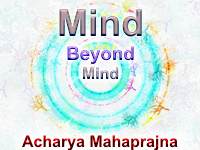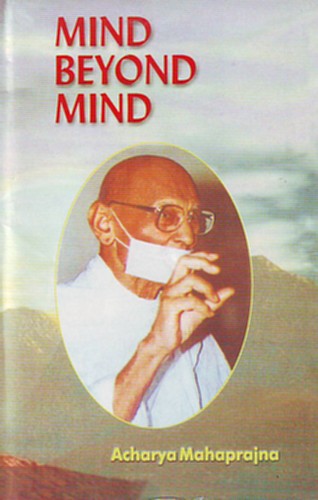
Meditation presupposes something to be meditated upon. There are several kinds of meditation and each has its own object. The choice of a particular kind of meditation should be made by keeping in mind the propensities of the meditator. Every kind of meditation does not suit every one. Some may easily concentrate on normal breathing, others on long breathing. Some can concentrate on both. Moreover, it is not necessary that every one should practise all kinds of meditation. There can be no uniformity in this respect. You may choose Preksha meditation or you may adopt Anupreksha meditation.
In this chapter I will discuss how to meditate on words. The subject of our discussion is Padastha Dhyana.
There are four main classes of meditation:
| 1 | Pindastha Dhyana | meditation on a material object |
| 2 | Padastha Dhyana | meditation on words |
| 3 | Rupastha Dhyana | meditation on forms and figures |
| 4 | Rupatita Dhyana | subtle meditation |
Padastha Dhyana refers to meditation on spoken words. The aim of this meditation is to control words. No one can continuously remain tongue tied, nor can one go on speaking endlessly. But if we choose to speak, we must first understand what words mean. We should also try to season words. The object to be meditated upon in Padastha Dhyana is words. We have to concentrate the mind on words. This is a step towards meditation on a higher plane.
Speech does not mean simply producing sounds. It is much more than pronouncing words. Words have meanings. They are embodiments of ideas. Then they are closely connected with respiration. They also express our dispositions. They carry with them powers, particularly our resolutions. Every word we pronounce is a manifestation of the power of the body, breath, air, sound, ideas and mental dispositions. We choose words to express powers. This choice depends upon our mental dispositions and judgment.
There is an ancient anecdote, which illustrates how the words we utter are expressive of our mental states or resolve. King Padmanabha had eloped with Draupadi, wife of the Pandavas. The Pandava brothers came to Amarakanka to retrieve her. A battle between the Pandavas and Padmanabha ensued. The former said, 'We may kill the adversary or he may kill us, but we have to fight.' This statement shows that they were not fully resolved. Their adversary proved to be the stronger and they began to desert the battlefield. Seeing this Krishna joined battle with Padmanabha saying, 'I will certainly win.' This statement was the expression of the resolve of Krishna and he defeated the adversary. What the Pandavas said reflected a lack of determination in them and what Krishna said expressed his confidence in his own power and strength of character. It is in this way that the words we choose express our mental dispositions.
When we pronounce the sacred word Arham, we produce a sound. It is said to be an auspicious utterance. You may ask as to why we should produce a sound before we begin to meditate. There is a rational explanation. Words carry the power of our dispositions and resolutions. They are not only sounds but also embodiments of our mental and spiritual states. The human brain and the rest of the body produce electric currents. The psychosomatic world in the human body is continuously active. This current is joined by another current produced in the body by friction. Combined together the two currents become the cause of psychosomatic transformation, which energises the body and the mind. The friction produced by the circulation of blood and respiration generate electric currents. Words are the explosions of breath on the mouth. They are electrically charged. The electric currents they contain are released through the mouth. They are also released through the ends of the fingers, toes, eyes etc. Speech thus carries electric currents. These currents shoot forth from the mouth and spread in the atmosphere. They strike the hearer before us.
In addition to the electric currents they carry, words also express our moods, dispositions and resolutions. This is the psychic energy contained in words. Words are, therefore, doubly charged. The electricity contained in words travels at the rate of 186,000 miles per second. Light from doubly charged words travels much faster. We have made supersonic aeroplanes, which travel faster than sound. Diamond cutters work at the rate of twenty thousand strokes per second. Diamonds are cut with the help of subtle sounds produced by the cutter. The power of words is thus a tremendous power.
Let us now discuss the nature of Padastha Dhyana. Firstly words are mediums. Arham is not an ordinary word. It is charged with the tremendous power of disposition towards an ideal, which can be achieved in meditation. An ideal is something to be achieved. A lot of creative effort has to be put in before we can achieve it. It is implied in the sounds and words we produce. Effort or sadhana makes it manifest.
Arham is the ideal, some thing to be realised through exertion. There are two forms in which ideals are embodied. The first is the symbolic representation in the form of an image. The other is the symbolic representation in the form of words. A sacred word or Mantra is repeatedly pronounced by the practitioner in order to establish his spiritual contact with the ideal, which the sacred word embodies. Arham means the state of the Arhat. The purpose behind uttering this word is to become conscious of the state, which is to be realized. By connecting the word with a strong disposition of our mind, we attempt to make the unmanifest manifested.
Words are symbols through which we express ideas or meanings. They should be understood with reference to these meanings. The word Arham, understood in this sense, acquires a new significance. This significance is the result of the combination of sound with a motive or disposition. The ideal is already in us. It is expressed through a combination of sound and disposition. The practitioner should choose a Mantra intelligently. Words are primarily concerned with breath. It should be clearly understood that breath plays a very important role in the entire process of sadhana. We should begin with words, which can be pronounced in a single breath, and we should also see that the pronunciation has the same rhythm which breathing has. Arham can be easily pronounced, even with a little prolongation, within the duration of a single breath. Then there are longer Mantras also like Namo Arihantanam, Namo Siddhanam, Namo Ayariyanam, Namo Uvajjhayanam, Namo Loe Savvasahunam. This Mantra contains five parts, each part capable of being pronounced in a single breath. The practitioner has to pronounce all these parts separately so that each may be uttered in a single breath. Moreover, the rhythm of each utterance should be harmonious with the rhythm of each breath. Once the two rhythms have become harmonious, they will easily produce concentration of the mind. In this concentration you will feel that sounds, words and breath are one harmonious unity.
We live in a world of vibrations. The somatic and extra-somatic atmospheres we live in are nothing but conglomerations of vibrations taking place ceaselessly. Atoms are whirling within and without us endlessly. You can see if you have the means to see, waves of atoms flowing in ceaseless currents. There is nothing solid in the world. Every thing is a conglomeration of electric currents and processes. A very little part of the universe is solid. What is solid in the human body is no bigger than the size of an atom. What is solid in the world is no bigger than the size of a tennis ball. The human body is composed of electric currents, breath currents, sound currents and thought currents etc.. These currents are called Paryayas in Jain philosophy. Paryaya means modification.
What we, therefore, need is to make a correct use of the vibrations of which we are composed and in which we live. We have to put to use the energy they produce. We must first learn to control the sound waves. Let us learn to connect them with the electric currents produced by the mind, with the waves of dispositions. And lastly, let us connect all these with the currents of breath. This connecting will become the source of infinite energy. Strong vibrations produced by words will ultimately become x-rays which travel at the rate of one crore of miles per second. The electric currents produced by dispositions induct additional energy in these currents. The net result is the generation of an irresistible motive force. The Acarya of Yoga have said that there is nothing impossible to achieve by a firm determination, a strong will. The power of words can be mastered by a strong faith. The practice of word control has to be in tune with the actualisation of faith. A word not connected with the power of faith is an empty word. Faith is like an armour. The practice of word control is likely to be disastrous if we do not put on the armour of faith.
 Acharya Mahaprajna
Acharya Mahaprajna

